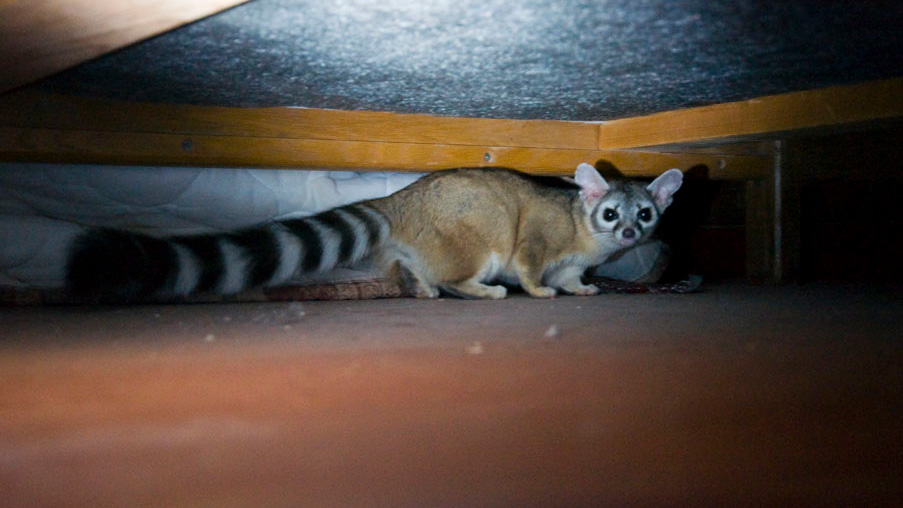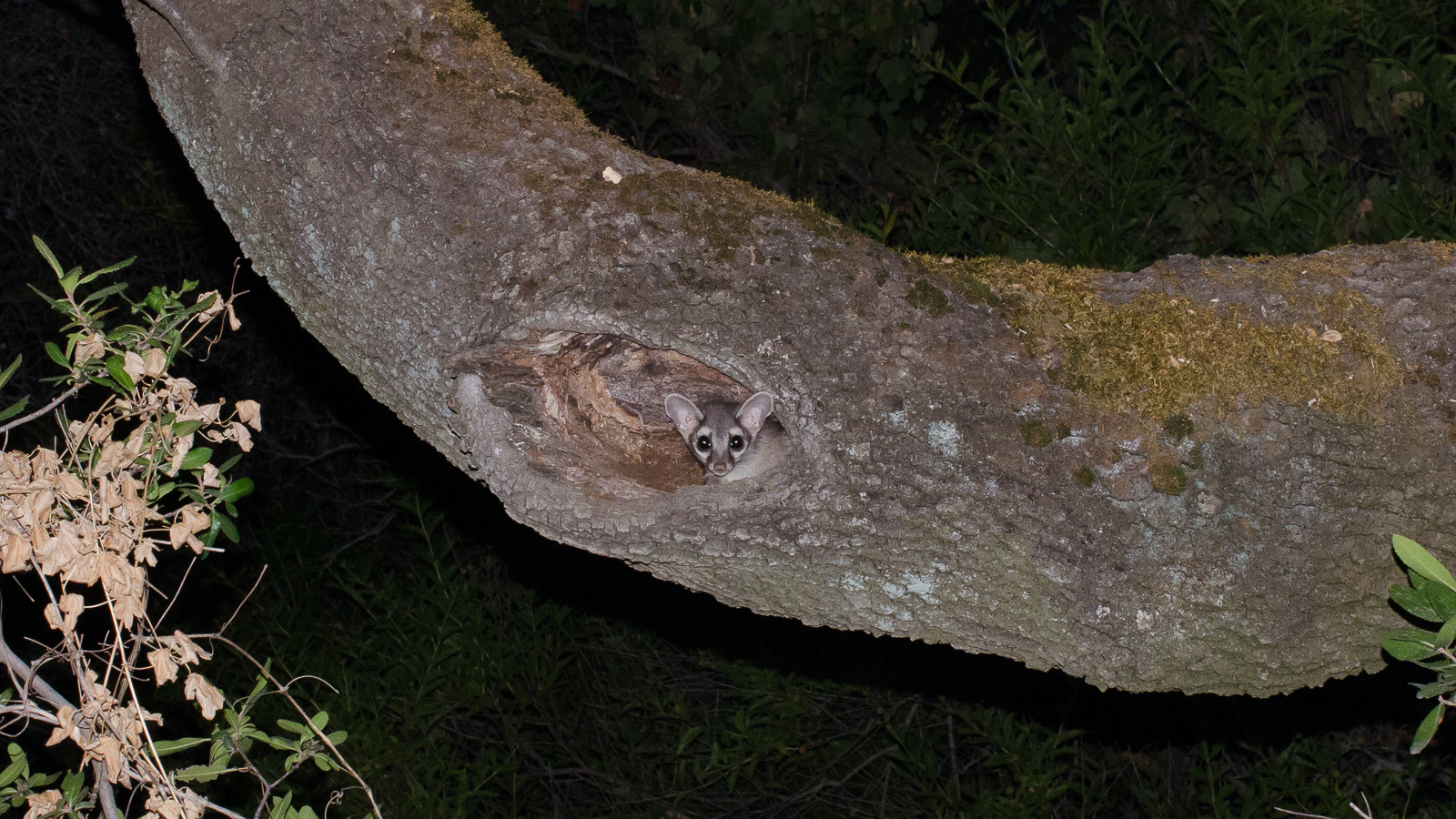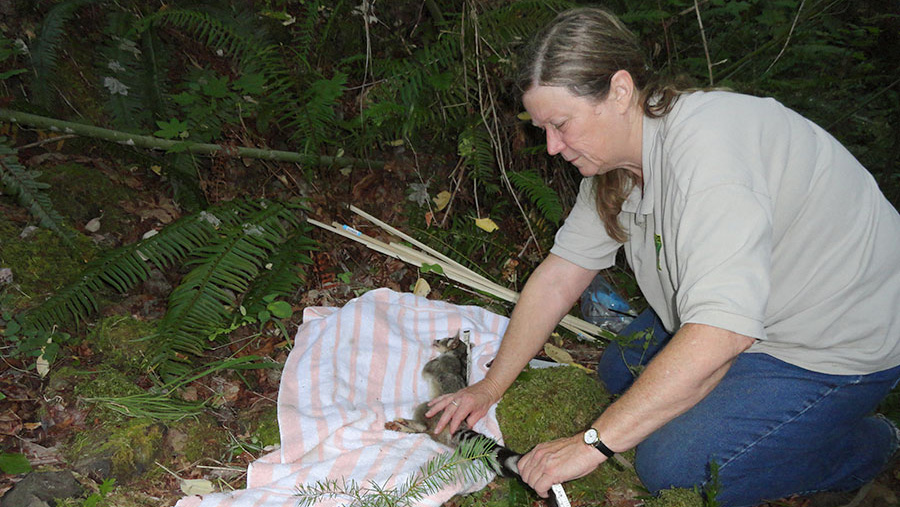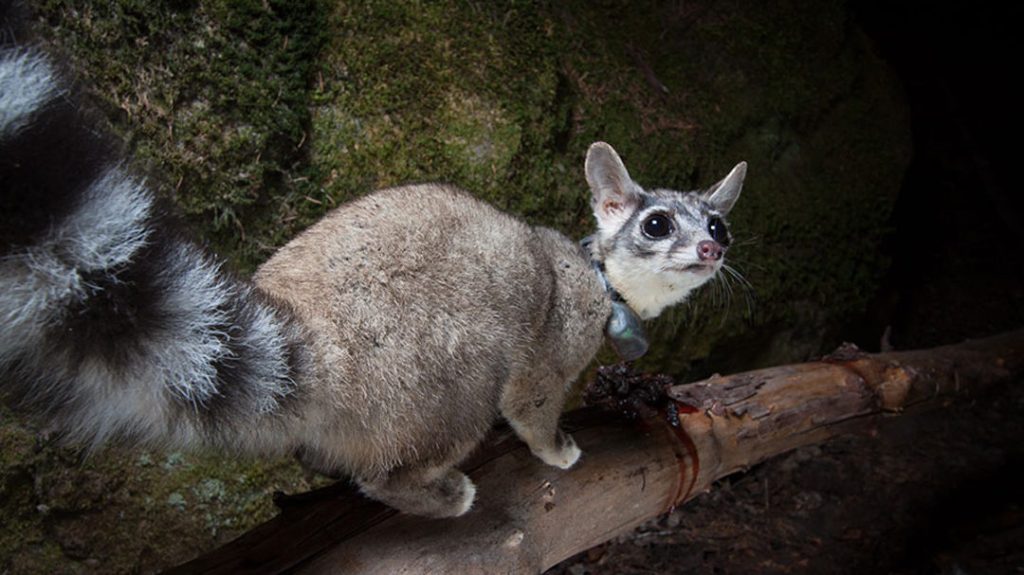Ring-tailed cat, miners cat, bassarisk, cacomistle; the ringtail (Bassariscus astutus) goes by many names. A ringtail by any name is just as cute.
As Rosemary Stussy, a retired Oregon Department of Fish and Wildlife biologist once put it, “on a scale of one to 10, their cuteness factor is a 15.”
“Cat” likely came into many of the common names for ringtails in part because ringtails are about the size of a house cat and in part because, as legend has it, gold rush era miners once enticed ringtails to live in their cabins as pet mousers.
But the ringtail is not a relative of the cat. And though its scientific name is based on an ancient Greek term for fox (βασσάρα), it is not a relative of the fox either. It is — as you may have guessed by the lovely long, ringed tail — more closely related to the raccoon. Both are members of the Procyonid family.
How to Spot a Ringtail
You may know ringtails as a desert southwest species (state mammal of Arizona), but ringtails have a much wider range. They can be found all the way up the west coast into southwestern Oregon and northeast as far as Oklahoma.
Ringtails are nocturnal, solitary, and sparsely populated throughout their range — factors that can make them a challenge to see in the wild. Watch for them at night in trees and shrubs near riparian areas (close to rivers and streams). Around February through May, when ringtails are breeding, you could catch sight of them during daylight hours.

Your best chance of seeing ringtails is at parks and preserves in the U.S. Southwest. Campsites in Grand Canyon National Park are frequently raided by crafty ringtails. Carlsbad Caverns National Park is another ringtail hotspot. Arizona has many birding lodges that put up an array of feeders, and these can attract other wildlife including ringtails. This is how I saw my first ringtails recently near Santa Rita Lodge in Madera Canyon (not to mention a coati and several bird species).
Though they are best known as shy creatures of forests, deserts and rocky areas, ringtails adapt well to living in disturbed areas and are frequently found near man-made buildings. You could have a ringtail living in your yard — they’ve rarely been known to show up in an attic.
“I found about six dens using radio-tracking equipment,” Stussy says. “None were up in trees. They were either down in a hole under a log or between boulders below the high-water mark of a lake – they would use the den in the summer when the water was low.”
If you can’t see a ringtail in the wild, it’s worth visiting a zoo to see one up close. The Oregon Zoo was home to ringtail kits last year.
Ringtail Tales
Ringtails are unusually carnivorous for a Procyonid. The bulk of their diet comes from animal matter (rodents, rabbits, squirrels, insects, birds, reptiles, frogs and carrion!). Ringtails do have a sweet tooth and eat fruit and nectar when available in the wild – Stussy attracted them to camera traps was with a mixture of raisins, jam, and a commercial “ringtail lure.”
Ringtails are sometimes prey to larger predators like great-horned owls, bobcats and coyotes.
When threatened the ringtail bristles the hair on its tail and arches it over its back to make itself appear larger (perhaps another reason for the cat comparison). As a final line of defense, ringtails will release a foul-smelling secretion and scream at a high pitch.
“They’re easily spooked,” says Stussy. “always jumping to the side. Their main predator is the great horned owl and I’ve seen video of a fisher making off with one in the snow. They have to watch out above and below.”

Mammals from ringtails to lemurs to tigers have rings on their tails, but the evolutionary benefit of this trait is not fully understood. It is thought that arboreal, nocturnal mammals like the ringtail might use their tails for communication. Some also hypothesize that it is a kind of camouflage or at least a distraction so that if predators do attack a ringtail, they are more likely to catch the readily visible tail, missing vital organs and giving the ringtail a chance to escape.
Ringtails do posture with their tail. Stussy saw in camera trap footage that ringtails sometimes raise their tail like a skunk in what looks like an aggressive gesture or arch it prettily over their back.
“They use their tail like a squirrel for balancing,” Stussy explains. “They can climb like crazy.”

Ringtails are top notch acrobats. In addition to the help from their tails, they have semi-retractable claws to get a good grip on rocks or tree branches and their hind feet can rotate at least 180 degrees – allowing them to quickly climb head-first down trees and rock faces.
Other incredible climbing behaviors include “chimney stemming” (i.e. pressing their feet against one wall and their back against another like the Grinch climbing up a chimney), “ricocheting” like a video game character bouncing back and forth between more distant walls, and “power leaping” accurately across large distances.
Conservation Needs
The IUCN classifies ringtails as least concern for conservation because of their wide distribution and ability to adapt to human inhabited areas. However, there is limited information on population densities and trends across their range, which makes it difficult to assess conservation needs.
“What is their range? Is it expanding or contracting? It would take a lot of effort to find out. Their home ranges are very small,” Stussy explains. “It needs more work like a lot of things. I hate to think of ringtails going the way of the fisher and nobody’s even looking at them to know it.”

Efforts are underway in Oregon to improve methods of assessing ringtail density as part of the Oregon Conservation Strategy. Stussy’s research initiated an effort to create a consistent ringtail monitoring protocol for Oregon using camera traps. Progress has been slow in part because it is currently unclear whether a low number of sightings in an area is a sign that there are low numbers of ringtails or that the protocol has failed for some other reason (like bears stealing the ringtail bait).
“My work generated a lot of interest,” Stussy says. “One article in the newspaper led to about a hundred calls from people who wanted to report seeing them.”
One promising area for future ringtail research is citizen science. If citizens could capture an image of a ringtail and report the sighting to a centralized database, that would provide far more data for the range and abundance of ringtails in the US than biologists are currently able to capture on their own.
There is not yet, to my knowledge, a dedicated ringtail citizen science project. In the meantime, you can report your ringtail (and other nature) sightings to iNaturalist.




What a beautiful species. Thank you for this article, the pictures and the video. Beautiful creatures!
Thanks for such an informative article on an interesting American species most Americans don’t even know about.
In 2014 my girlfriend lived in Northern New Jersey next to an expansive wilderness area, High Mountain Park Preserve. The Park is a protected area in the Preakness Range of the Watchung Mountains in Wayne, New Jersey, it comprises 1,153 acres of woodlands and wetlands owned and managed by The Nature Conservancy. When I visited on there on three or four occasions we spotted these creatures and at first had no clue whatsoever what this mammal could be! The huge tail and big eyes were unmistakeable. We knew it was definitely no cat and with those eyes, no raccoon either! Honestly was an amazing site! After researching and finding photos of the ringtale, we are 100% positive we had spotted these rare creatures and continued to see them on occasion, honestly it could have been the same one, who knows. Everything we read insisted the habitat that was thought to be very far from this region, with Manhattan only 17 miles away! The ringtails were on the property of a densely populated townhouse community, perhaps someone was feeding them. Like raccoons, they certainly must know where to find a good meal. I’m so amazed that somehow these creatures managed to make their way to Wayne, NJ…but there they were. Wish I had been able to get a photo but we only saw them at night.
If it was a ringtail, it could have gotten caught on a truck headed there and then escaped into the area when the truck stopped – there was one found in a store in a part of Oregon where they aren’t usually found and it is thought that it got there on a truck making a delivery.
This little critter is Stinkin’ Cute!
wow they are soooo cute
I think Ring tail cats are a beautiful so called creature I wish we could find them in the North East As of close to Wisconsin area.Especially in the camping area of the forest of Wis. I’de love to be able to see one up close.They kind of favor’s lemur’s to me or a smaller raccoon family member.
Hi Sharon, Yes! Even though they live so far from lemurs and aren’t primates, there’s a strong resemblance in coloration. It seems to be an example of convergent evolution – http://slatermuseum.blogspot.com/2012/05/ringed-tails.html . I hope you get a chance to see one up close while on vacation some time, it really is a treat.
Great to see photos of these little raccoon cousins! Saw them last on a Colorado River trip in the Grand Canyon about 30 years ago. They may be shy, but when it comes to food or trash they are persistent
I’ve not seen any in Oregon yet but saw them several times in extreme northern California–once a mother with young ones (Trinity County).
I saw one while driving at night in SW Oregon a few years ago up above the Illinois River just on the border of the large Biscuit fire close to Cave Junction. I have spent a lot of time in the woods and that was my first sighting of one. My dad used to spend a lot of time going in and out of the old gold mines back in the late 60’s and early 70’s along the Rouge River and he said he saw them frequently inside of those. One of the mines I remember was the Almeda mine that he saw them in.
Blast! I stayed at Santa Rita Lodge in Madera Canyon and the only mammals I saw were White-tail deer & Cotton Rats.
Feb / March seemed like a good time to go for mammal sightings, though there was probably also some luck involved. The birding is supposed to be better in the summer. I saw a lot of cool birds in winter, but I didn’t see many hummingbirds while I was there – there were one or two broadbills. Some others saw a magnificent hummingbird, but I wasn’t at the feeders at the right time to see it.
I saw ringtails a couple of times while working at the Grand Canyon, Sneaky guys would get into the restaurants.
To the “youngsters” who read this , it may seem like ancient history, but in 1971 I saw photos taken at the summit of Mount Diablo in Contras Costa County, California of two ringtails. It is the last “verified” siting I am aware of from that State Park. I have asked many people about sighting them. Most are not even aware the cute little beastie even lived in the area. Because of their secretive nature it is probable they still inhabit the area but I would love to get involved with a group setting up lures and cameras to see if this fascinating creature is still hanging out.
I live in Oreogn and haven’t seen any ringtails here, but I had an encounter with one in a state park just outside St. George in the southwest corner of Utah. A friend and I were tent-camping there and forgot to put cooked meat away in the cooler. In the middle of the night, a ringtail feasted on what we left on the picnic table. I couldn’t see it very well with my headlamp, except for the ringed tail.
I grew up in southwest Oregon, later lived in the Colorado Rockies, and have spent a lot of time hiking and camping through out much of this animal’s range– but I have never seen one! I do remember my grandfather talking about seeing them on their small farm in the foothills of the Siskiyou Mountains along the Oregon/California border. He described them vividly, and I recognized the animal immediately (pretty hard to get that one wrong!). The first thing that popped into my mind when I saw your photo was “civet cat”, which is what he called them. But when I looked up civet cat, it is an Asian animal that doesn’t look at all like the bandtail, and that name doesn’t appear on your list of alternative names. Then I looked at the range map you linked to, and it had civet cat as one of the names. My grandfather was born in Kansas in a family with southern roots. Perhaps that’s where he picked up the name.
Now I am so intrigued that I want to go visit a friend of mine who still lives in the mountains in that area, and hang out in the dark hoping for a glimpse! If I weren’t several decades past the age to do this kind of thing, I think I’d spend all my time doing population studies on this little cutie! (Though my friend, same age as me, is a retired naturalist/ranger/biologist. Hmmm….)
Dave Wyatt, who teaches Field Biology at Sacramento City College, has been studying the ringtails in the Sutter Buttes north of Sacramento for decades, following in the footsteps of Gene R. Trapp. Their population density there is the greatest ever recorded and their home ranges the smallest, indicating an abundance of food. Native mistletoe is an important staple food, consumed 10 months out of the year. I recognize one den site in a photo in this article from a great talk Dave gave last week at our California Native Plant Society local chapter.